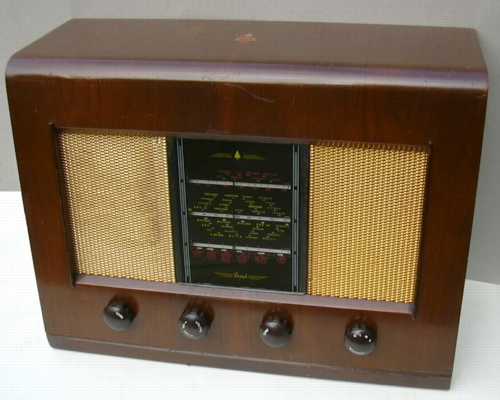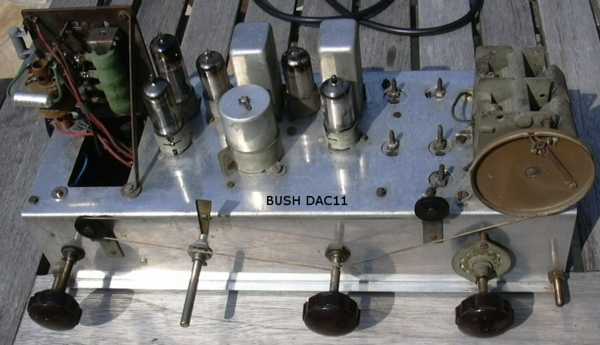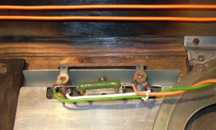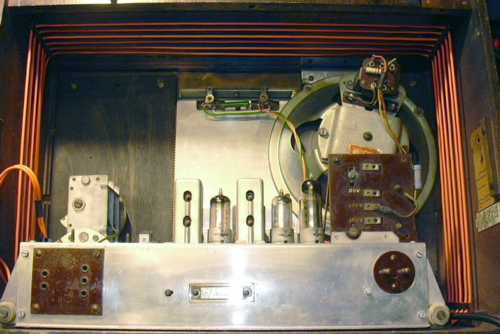

Bush DAC11 5 valve radio in veneered wood case with LW MW and SW bands and provision for pick up, internal frame aerial and external speaker. This is an AC/DC version of the AC11, the essential difference being that that the latter has an isolating transformer rather than a resistive voltage dropper. Valve lineup UCH42, UF41,UBC41,UL41, UY41
The chassis is held in place by two screws and two pegs enabling it to be slid out from the case leaving the speaker, frame aerial, dial lamps, glass dial and pointer in the case. Connections to the frame aerial, speaker and dial lamps are via plugs which mate with sockets on the chassis.

This recently acquired radio was in poor condition but apparently complete apart from missing dial glass, dial lamp holders and external loudspeaker panel. At sometime in the past the insulation covering the frame aerial had obviously caught fire so I removed the wiring, cleaned the inside of the case and replaced it with the orange flexible cable which you can see in the photos below.

I purchased a dial glass from Pasttimesradio.co.uk and rewound the frame aerial using PVC covered wire and made a bracket to support two dial lamp holders. A new mains lead has been fitted directly to the switch on the volume control (bypassing the potentially dangerous two pin plug and socket arrangement). The output transformer has been removed from the chassis and mounted on the rear of the speaker where it originally belonged. I have cleaned the chassis, fitted a mains RF 0.01 mfd 1000 volt bypass capacitor and replaced the 150 ohm surge limiter in series with the rectifier.
The electrolytic HT smoothing capacitors appeared to be well enough to try the set. It worked, sort of! I was able to get a tuneable (though distorted) audio signal on all three wave bands. The volume control and wave band switch were noisy and have been cleaned with contact cleaner, but I had to take the volume control apart to clean the track.
I then disconnected the electrolytic capacitors an used a "megger insulation tester on the now isolated HT line to discover that several of the TCC wax covered paper capacitors were leaky, these were removed one by one and replaced with modern components slid inside the original waxed paper outer coverings.
On energising the radio again I found that the output was still distorted and by checking a few voltages against the service data decided it was time to test the valves in my AVO valve tester. Sure enough the UL41 and the UBC41 were seriously under par. I had no spares, but wait a minute, the same valves are used my Bush DAC90A which works fine. I check its valves and they are OK. Swapping the UBC41 from the DAC90A to the DAC11 does the trick!

It is interesting to see the similarities between the two radios and to realise that this, the more expensive set, has fundamentally the same the same circuit as the cheaper Bakelite model so popular with collectors today. click here
These sets were introduced in 1949 and sold for � 17.13s.6d plus Purchase tax
Some History
Bush rose from the ashes of Amplion who made speakers for British Gaumont cinemas and thus had links with the film industry.The radios were advertised in Gaumont cinema foyers as "A Gaumont British Product". Murphy experienced problems keeping at the forefront of technology and lost creditability with their dealers, many of which changed over to Bush. At some point Murphy became part of Bush and the company trade as Bush - Murphy in Chiswick, London. In 1945 because of their links to the film industry, Bush Murphy became part of the Rank empire and changed the name to Rank Bush Murphy (RBM). A new satellite factory was opened in Plymouth in 1949. During the mid 70's (When they were one of my major customers! I worked then for RCA Solid State having previously been with both Mullard & STC) ) they moved the entire operation to Plymouth. In 1972 the name was changed again to Rank Radio International (RRI). Following several years of mounting losses they tied up with the Japanese to become Rank Toshiba in 1978. This lasted just 3 years, and in 1981 finally folded. Toshiba became sole owner of the Plymouth factory. The Bush name now belongs (along with Alba) to an importers in Barking, E London.
Thanks to Colin Boggis for this information
How much is it worth? �40
Have a look at this site for a very comprehensive and interesting history of Bush radios http://www.bushradio.co.uk/

